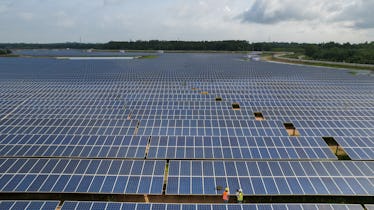
A glimpse of starlight could potentially unveil alien construction to upcoming telescopes, according to a recent study. Specular reflection, akin to sunlight bouncing off a shiny object in one direction, may aid in detecting alien cities on far-off planets in the foreseeable future.
In a hypothetical scenario set in 2037, astronomers examining data from the Habitable Exoplanet Observatory (HabEx) notice a sudden bright flash on a distant, Earth-sized planet as it transitions from day to night. This observed flash prompts astronomers to delve deeper into the data, analyzing details such as the surface area emitting light and the polarization of the light waves. Subsequent rotations of the planet reveal repeated flashes with highly polarized light, indicative of starlight reflecting off smooth, reflective surfaces – potentially alien-made structures like solar farms or industrial complexes.
Astronomer Bhavesh Jaiswal from the Indian Institute of Science suggests that upcoming telescopes like HabEx and the Nancy Grace Roman Space Telescope could make this alien discovery plausible within the next decade. Jaiswal’s recent paper in the journal Astrobiology outlines calculations on the required surface area coverage of reflective material for Earth-based telescopes to detect specular reflections.
The future of astronomy could see direct imaging capabilities by telescopes like HabEx or the Roman telescope, enabling the observation of starlight reflecting from planetary surfaces. While Webb’s current exoplanet studies focus on gas giants, future imaging may shift towards habitable, Earth-like planets. If aliens have constructed shiny structures on their planets, the reflections may reach telescopes on Earth, much like a signal mirror.
Distinguishing between natural and artificial specular reflections may pose challenges, especially considering false positives from non-artificial sources such as oceans or icy surfaces. However, analyzing the polarization of light could help differentiate between smooth, reflective surfaces like metal and natural features like lakes or glaciers.
As the scientific community anticipates future advancements in telescope technology, the possibility of alien megastructures or smaller scale cities becoming visible is on the horizon. Astronomers emphasize the importance of preparing for potential unknown discoveries on distant worlds, underscoring the need to anticipate future scientific goals and engineering requirements for upcoming missions.

